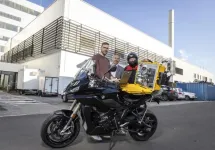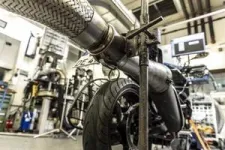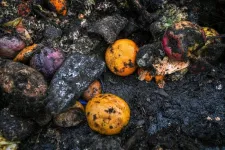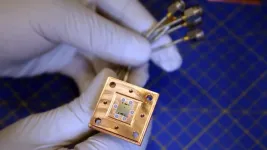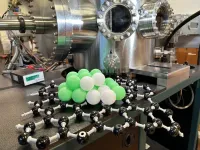(Press-News.org) The emissions scandal in the automotive industry that came to light in 2015 has set many things in motion. Last but not least, the discussion about the need for realistic tests for vehicles in order to correctly determine their pollutant emissions instead of just testing on test rigs. Such tests and the applicable emission limits are now required by law for cars, but not for so-called category-L vehicles (mopeds, motorbikes, tricycles and quads). As part of the “LENS” project (L-vehicles Emissions and Noise mitigation Solutions) funded by the European Commission, Graz University of Technology (TU Graz), as part of an international consortium, has now developed corresponding test procedures and the necessary test equipment. The project results will serve the legislator as a basis for future decisions, provide law-enforcement agencies with the equipment to detect limit violations and vehicle manipulation, and allow manufacturers to adapt their fleets accordingly.
Worldwide unique methodology and technology
“The measurement methods developed for passenger cars in recent years are not applicable to the much more dynamic category-L vehicles,” says Stephan Schmidt from the Institute of Thermodynamics and Sustainable Propulsion Systems at TU Graz. “So, we had to develop our own measuring methods, which also included the development and further development of suitable measuring devices that are small and light enough to be used on motorbikes and mopeds. The measurement methodology and technology developed and the emissions data collected are unique worldwide.” A total of 15 partners are involved in the project consortium, including nine research institutions, four manufacturers of two-wheelers and producers of measurement technology.
As part of “LENS”, the project consortium measured a total of 150 vehicles on the road and in the laboratory, 40 of them at TU Graz alone. The Institute of Thermodynamics and Sustainable Propulsion Systems and the Institute of Electrical Measurement and Sensor Systems were responsible for developing and creating the measurement methodology and some of the measurement technology for all project participants. In addition to the creation of route profiles suitable for tests with all category-L vehicle types, the miniaturisation of the measurement technology was a particular challenge. While equipment weighing more than 60 kilograms does not play much of a role in a car, it makes a huge difference on a motorbike and especially on mopeds – both in terms of pollutant emissions and riding characteristics. For motorbikes, the necessary reduction in size and weight was achieved by involving an external partner. For the weaker vehicles, a consortium partner contributed small measuring devices which, although not as accurate, provide good reference values.
A mix of all classes and driving styles
Creating the route profiles was challenging because a scooter with just a few horsepower is completely different to ride compared with a motorbike with over 100 horsepower. In the end, the researchers found a good mix that included both sporty and hilly sections and took different vehicle classes and driving styles into account. However, the wide range of drive systems, drive outputs, installation space ratios and vehicle masses required a measurement methodology adapted to the subclasses. Precise measurement of the exhaust gas mass flow is crucial for calculating emissions. With small-volume single-cylinder engines, however, mass flow measurement using conventional methods is difficult. However, the model-based method for mass flow calculation developed at TU Graz and used in the LENS project provided a solution. As the vehicles in the lower performance classes can be fully extended on the test bench, the researchers were able to create a model based on the test bench data, from which the mass flows during the journey can be calculated. This enabled the team to obtain usable emission data from the reference values of the small measuring devices.
“The many engine concepts and performance classes in the L-vehicle sector are a challenge when it comes to finding standardised test methods that realistically measure noise and exhaust emissions,” says Stephan Schmidt. “In the LENS project, however, we have succeeded in doing this and, together with our consortium, we have created the technical basis for manufacturers, legislators and law enforcement agencies to be able to assess vehicles on the basis of realistic values in future. This will contribute to a significant reduction in pollutant emissions from the category-L vehicle fleet.”
END
Realistic emission tests for motorbikes, mopeds and quads
As part of an international project consortium, Graz University of Technology has developed new measurement techniques and methods to measure emissions from category-L vehicles in realistic operation and to determine corresponding limit values.
2025-01-09
ELSE PRESS RELEASES FROM THIS DATE:
Race- and gender-based microaggressions linked to higher post-birth blood pressure
2025-01-09
Research Highlights:
More than one-third of Asian, Black and Hispanic women in the study group reported experiencing at least one microaggression related to race and gender during or after their pregnancy.
The link between racial microaggressions and postpartum blood pressure was strongest 10 or more days after delivery, when the blood pressure may be monitored less often, the researchers noted.
The researchers also noted that these types of gendered racial microaggressions can raise blood pressure postpartum and suggest blood pressure monitoring and/or treatment for high blood pressure may need to ...
Novel ‘quantum refrigerator’ is great at erasing quantum computer’s chalkboard
2025-01-09
If you’d like to solve a math problem on a good old-fashioned chalkboard, you want the board clean and free of any previous markings so that you have space to work. Quantum computers have a similar need for a clean workspace, and a team including scientists at the National Institute of Standards and Technology (NIST) has found an innovative and effective way to create and maintain it.
The research effort, a collaboration with physicists at Sweden’s Chalmers University of Technology, could address one of the main issues confronting quantum computer designers: ...
States struggle to curb food waste despite policies
2025-01-09
The United States generates more food waste than all but two countries. To address this, the federal government set a goal to cut food waste in half by 2030 compared to 2016 levels, to about 164 pounds per person annually. But a new study published in Nature Food and led by University of California, Davis, reveals that current state policies are falling short. Since 2016, per capita food waste has increased instead of decreasing.
“We’re just five years away from 2030 so it’s quite alarming how ...
Record cold quantum refrigerator paves way for reliable quantum computers
2025-01-09
Quantum computers require extreme cooling to perform reliable calculations. One of the challenges preventing quantum computers from entering society is the difficulty of freezing the qubits to temperatures close to absolute zero. Now, researchers at Chalmers University of Technology, Sweden, and the University of Maryland, USA, have engineered a new type of refrigerator that can autonomously cool superconducting qubits to record low temperatures, paving the way for more reliable quantum computation.
Quantum computers have the potential to revolutionise fundamental technologies in various sectors of society, with applications in medicine, energy, encryption, AI, and logistics. While the building ...
New discovery makes organic solar cells more efficient and stable
2025-01-09
EMBARGO 9.1.2025
New discovery makes organic solar cells more efficient and stable
Researchers at Åbo Akademi University in Finland have identified and eliminated a previously unknown loss mechanism in organic solar cells that makes them more efficient and gives them a longer lifetime. The results provide new insight into how efficiency and stability can be increased in the future.
The work of the Organic Electronics Research Group at Åbo Akademi University was carried out in cooperation with Professor Chang-Qi Ma's group at Suzhou Institute ...
What we eat affects our health — and can alter how our genes function
2025-01-09
Fiber is well known to be an important part of a healthy diet, yet less than 10% of Americans eat the minimum recommended amount. A new study from Stanford Medicine might finally convince us to fill our plates with beans, nuts, cruciferous veggies, avocados and other fiber-rich foods. The research, which will be published in Nature Metabolism on Jan. 9 identified the direct epigenetic effects of two common byproducts of fiber digestion and found that some of the alterations in gene expression had anti-cancer actions.
When we eat fiber, the gut microbiome produces short-chain fatty ...
Lung cancer test predicts survival in early stages better than current methods
2025-01-09
ORACLE test predicts overall cancer survival independent of currently used clinical risk factors, and it has the best predictive power in stage 1 lung cancer.
A high ORACLE score is associated with a higher risk of cancer spread.
ORACLE could potentially be used to pick out patients who would benefit most from chemotherapy.
Researchers at the Francis Crick Institute, the UCL Cancer Institute and UCLH have shown that a test called ORACLE can predict lung cancer survival at the point of diagnosis better than currently used clinical risk factors. This could help doctors make more informed treatment decisions for people with stage ...
Pioneering new mathematical model could help protect privacy and ensure safer use of AI
2025-01-09
UNDER EMBARGO UNTIL 10 AM GMT / 5 AM ET THURSDAY 9 JANUARY 2025
Pioneering new mathematical model could help protect privacy and ensure safer use of AI
AI tools are increasingly being used to track and monitor us both online and in-person, yet their effectiveness comes with big risks. Computer scientists at the Oxford Internet Institute, Imperial College London, and UCLouvain have developed a new mathematical model which could help people better understand the risks posed by AI and assist regulators in protecting peoples’ privacy. The findings have been published today (9 January) in Nature Communications.
For ...
Floods, droughts, then fires: Hydroclimate whiplash is speeding up globally
2025-01-09
Key takeaways
Hydroclimate whiplash – rapid swings between intensely wet and dangerously dry weather – has already increased globally due to climate change, with further large increases expected as warming continues, according to a team of researchers led by UCLA’s Daniel Swain.
The “expanding atmospheric sponge,” or the atmosphere’s ability to evaporate, absorb and release 7% more water for every degree Celsius the planet warms, is a key driver of the whiplash.
Co-management of extreme rainfall or extreme droughts, ...
Scientists fuel sustainable future with catalyst for hydrogen from ammonia
2025-01-09
Scientists have created a catalyst for hydrogen generation from ammonia that becomes more active with time, and by counting atoms revealed changes that boost the catalyst’s performance.
A research team from the University of Nottingham's School of Chemistry, in collaboration with the University of Birmingham and Cardiff University, has developed a novel material consisting of nanosized ruthenium (Ru) clusters anchored on graphitized carbon. These Ru nanoclusters react with ammonia molecules, catalysing splitting ammonia into ...
LAST 30 PRESS RELEASES:
Heart-brain connection: international study reveals the role of the vagus nerve in keeping the heart young
Researchers identify Rb1 as a predictive biomarker for a new therapeutic strategy in some breast cancers
Survey reveals ethical gaps slowing AI adoption in pediatric surgery
Stimulant ADHD medications work differently than thought
AI overestimates how smart people are, according to HSE economists
HSE researchers create genome-wide map of quadruplexes
Scientists boost cell "powerhouses" to burn more calories
Automatic label checking: The missing step in making reliable medical AI
Low daily alcohol intake linked to 50% heightened mouth cancer risk in India
American Meteorological Society announces Rick Spinrad as 2026 President-Elect
Biomass-based carbon capture spotlighted in newly released global climate webinar recording
Illuminating invisible nano pollutants: advanced bioimaging tracks the full journey of emerging nanoscale contaminants in living systems
How does age affect recovery from spinal cord injury?
Novel AI tool offers prognosis for patients with head and neck cancer
Fathers’ microplastic exposure tied to their children’s metabolic problems
Research validates laboratory model for studying high-grade serous ovarian cancer
SIR 2026 delivers transformative breakthroughs in minimally invasive medicine to improve patient care
Stem Cell Reports most downloaded papers of 2025 highlight the breadth and impact of stem cell research
Oxford-led study estimates NHS spends around 3% of its primary and secondary care budget on the health impacts of heat and cold in England
A researcher’s long quest leads to a smart composite breakthrough
Urban wild bees act as “microbial sensors” of city health.
New study finds where you live affects recovery after a hip fracture
Forecasting the impact of fully automated vehicle adoption on US road traffic injuries
Alcohol-related hospitalizations from 2016 to 2022
Semaglutide and hospitalizations in patients with obesity and established cardiovascular disease
Researchers ‘listen in’ to embryo-mother interactions during implantation using a culture system replicating the womb lining
How changing your diet could help save the world
How to make AI truly scalable and reliable for real-time traffic assignment?
Beyond fragmented markets: A new framework for efficient and stable ride-pooling
Can shape priors make road perception more reliable for autonomous driving?
[Press-News.org] Realistic emission tests for motorbikes, mopeds and quadsAs part of an international project consortium, Graz University of Technology has developed new measurement techniques and methods to measure emissions from category-L vehicles in realistic operation and to determine corresponding limit values.
